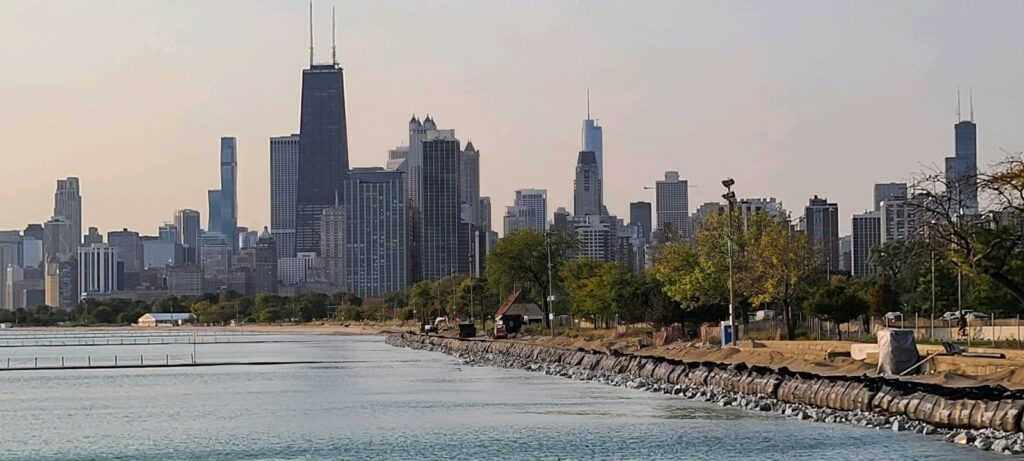Combating Rising Water Levels in Chicago with Flood Barriers
As flooding presents a growing danger to cities such as Chicago, learn how TrapBag can protect your land, property, and more.

Rising Water Levels & Floods in Chicago
What is Flooding?
Flooding is an overflow of water onto land that is normally dry. Floods can be caused by an array of natural and unnatural occurrences, including snow melting, rising water levels, and more. Unfortunately, they can lead to a multitude of unwanted destruction, from ruining home basements to making streets undriveable.
Why are Floods Happening in Chicago?
Sandwiched between Lake Michigan and the Mississippi River Basin and built on top of a swamp, Chicago is in a predicament we have never experienced before. As climate change becomes more and more extreme, Chicago’s surrounding bodies of water do as well, particularly Lake Michigan. For 8 whole months in 2020, Lake Michigan hit record high water levels, leading to flooding and the destruction of homes, docks, and shorelines. As time goes on, these issues are only expected to get worse.
History of Flooding in Chicago
Due to its location, flooding has not been historically uncommon in Chicago. Historically significant floods have occurred in 1848, 1855, 1885, 1938, 1952, 1954, 1957, 1961, 1973, 1979, 1986, 1987, 1992, and 1996. The most significant and damaging of these floods have occurred post-1948.
Effects of Flooding in Chicago
Flooding presents a large array of harmful impacts, particularly on urban communities like Chicago. From the introduction of water-borne diseases to the destruction of countless homes and businesses, floods have presented a danger like no other. Studies have also shown that it is often the most vulnerable populations that are hit the hardest.
Other impacts of flooding in Chicago include:
- Disposal of waste into Lake Michigan;
- Flooding of basements, which often includes waste water;
- And more.
Flooding Prevention Methods
Although the future of climate change remains uncertain, one thing is clear: unless something is done, flooding will continue to be a danger to Chicago citizens. Luckily, there are solutions available to assist in mitigating – or preventing completely – the negative impacts of flooding.
Flood Barriers
Flood barriers are a type of floodgate used to prevent water – generally, from a flood – from entering a particular area. These devices can be installed permanently or temporarily, and can be made from an array of materials, such as metal, glass, or cement.
Dikes/Dams
Dikes and dams are ridges that help to regulate water levels. However, they differ in the fact that dikes only have water on one side of the barrier, while dams have water on both. Dikes are often used to protect against or prevent flooding. On the other hand, dams work to retain water.
Drainage
Drainage can be an effective method for flooding prevention as it redirects water from your property. There are multiple kinds of drains available to prevent flooding.
Natural Flood Management
Natural flood management, otherwise known as working with natural processes, is the process of imitating functions of natural characteristics, such as rivers, floodplains, and more. This solution to flooding can include creating new natural characteristics, such as creating coastal salt marshes, or rebuilding old characteristics, such as restoring bends in rivers.
Using TrapBag® as a Flood Prevention Method in Chicago
As flooding presents a growing danger to cities such as Chicago, one question stands above the rest: how can we protect our land, property, and ourselves?
Recently, an article in the New York Times illuminated this issue and offered a potential solution: TrapBag®. Lining roads and shorelines, TrapBags® were used in the city of Chicago to protect roads, lakeside houses, and more from the damaging effects of a rising Lake Michigan.
Trapbag Flood Barriers
TrapBag® Flood Barriers can be used as temporary or semi-permanent solutions against flooding to protect complete cities, city areas, or private residences.
How Do TrapBag® Flood Barriers Work?
TrapBag® is a series of pentagon-shaped bags that are sloped on one side, vertical on the opposite side, and open at the top for filling. Each of the cells are connected side by side like an accordion, each cell has a common wall with the next cell, and are collapsed during storage and deployment. The cells are made of high-strength textile. Each of the cells are self-contained yet rely on the next cell for added strength. If one of the cells is compromised, it will not affect the rest of the flood barrier, which will remain standing strong. TrapBag® Barriers can be filled with sand, washed gravel, or concrete.
TrapBag® Flood Barriers can be used to build dams, dikes, levees, water barriers, and other forms of flood protection.
Advantages of TrapBag® Flood Barriers
TrapBag® Flood Barriers use 40% less fill material than a stacked sandbag wall, but more importantly one 100 foot section of 4 foot high TrapBag® replaces approximately 8,000 sandbags making TrapBag® Flood Barriers an excellent alternative to small and large sandbags. They are a tried and tested solution that is proven to keep your home, property, and family safe.
Learn More About TrapBag® Products & Solutions
Are you ready to take the next step in protecting your home from the dangers of flooding? Look no further. The TrapBag® team is here and ready to help you. Order your TrapBag® Flood Barrier today or reach out to us.[/vc_column_text][/vc_column][/vc_row]
Get the Dirt Before the Flood Hits
Stay ahead of flooding, erosion, and disaster response challenges. The Dirt, TrapBag’s monthly newsletter, delivers field-tested tips, real-world case studies, and the latest in barrier technology straight to your inbox.
